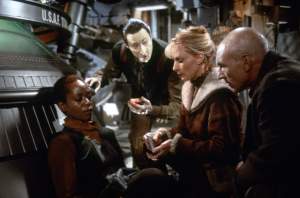Faneuil Hall

SeanPavonePhoto/istock
Today, Faneuil Hall is the home to over 200,000 square feet of space occupied by 80+ retailers and is one of the most visited historical sites in the United States. It’s steps from Government Center and not far from modern Boston landmarks like TD BankNorth Garden and the New England Holocaust Memorial.
The hall was constructed in 1742 by Peter Faneuil and was donated to the city to be used as a community meeting space and marketplace. Later, Quincy Market was added in 1826 to accommodate the city’s expanding population. It’s a great place to visit on a tour of Boston when it’s time to grab a quick bite to eat.
Old North Church

drnadig/istock
The Old North Church, located in the beautiful North End of Boston, is the oldest standing church in the city and best known for its role in Paul Revere’s famous midnight ride. The site was established in 1723 as the Christ Church in the City of Boston and still has an active Episcopalian congregation today.
There are free self-guided tours of the church during regular business hours, though to explore the bell tower, balcony, and crypts (the final resting place of 1,100 former congregants) you’ll have to sign up for one of the guided tours and pay a small fee.
Old State House

bloodua/istock
The Old State House was built in 1713 and is the oldest surviving public building in the city of Boston. The site has been the location of many historical events, including the first reading of the Declaration of Independence in the Commonwealth of Massachusetts.
Only steps away from Faneuil Hall, the building is now the home to the Revolutionary Museum, and for a nominal fee, visitors can take a self-guided tour and explore interactive exhibits filled with period-appropriate furniture and artifacts. The Council Chamber is particularly impressive, and any history buff is likely to get goosebumps entering a space where so much history transpired.
Potato Shed Memorial

roman_slavik/istock
If you find yourself near Bunker Hill and are looking to see one of the more peculiar Boston monuments, then be sure to visit the quaint Millers River Potato Monument. There, you’ll find a well-crafted statue of four burlap sacks, filled and overflowing with potatoes, as well as a plaque with a fun inscription we won’t dare spoil.
The site memorializes the potato sheds that were a fixture of Charlestown from the mid-1800s until they burned down in the early 1960s. Old-timers will tell you that the neighborhood smelled of roasted potatoes for weeks after the tragic fire.
Historical Burying Ground Sites

Mindaugas Dulinskas/istock
Anyone who has traveled along the historic Freedom Trail in Boston will be familiar with three of the city’s burying grounds, but there are sixteen different sites in and around the city.
The oldest graveyard (and for 30 years, the only graveyard) is King’s Chapel Burying Ground on Tremont Street, founded in 1630. It is the final resting place of historical figures like Mary Chilton, the first woman to step off the Mayflower, and the first governor of Massachusetts, John Winthrop.
Each of the sixteen sites is worth visiting, with its own unique history, urban legends, and famous historical residents.
Boston Light

ny_2003/istock
There are three lighthouses in the Boston Harbor: Long Island Light, Graves Light, and Boston Light.
Boston Light is the oldest lighthouse in the entirety of what would eventually become the United States, and was built on Little Brewster Island and first lit in 1718. It was the most important navigational marker for those approaching the harbor until the construction of the Graves Light in 1905.
There are plenty of harbor tours that will take you to view these historic landmarks, and depending on the time of year and other extenuating circumstances some will even take you to explore Little Brewster Island.
Boston Athenæum

cineman69/istock
Boston Athenæum, located on Beacon Street, steps from Beacon Hill and the Common, is one of the oldest private libraries in the United States. It was founded in 1807 by the Anthology Society to provide the growing city with a center for art, literature, and intellectual conversation.
Today, it is a combination of a library, an art gallery, and a cultural exhibition space for lectures and concerts. For a nominal fee, visitors are welcome to explore the five floors of books and reading space and view the expansive collection of paintings and sculptures. Even the building itself is an interesting architectural space worth exploring.
Paul Revere House

dosecreative/istock
The Paul Revere House is another must-see stop on Boston’s famed Freedom Trail. The house itself is the oldest structure in Downtown Boston, constructed in 1680-ish and was owned by famous silversmith and patriot Paul Revere for thirty years from 1770 to 1800.
The tour can be done in less than an hour as you explore the home room by room viewing old furniture and artifacts of the home’s historical residents. Pro-tip: try to schedule your visit for an off-peak time or season as the small rooms can become quite cramped during busy hours and it may sour the experience.
Boston Tea Party Ships and Museum

travelpixpro/istock
The Boston Tea Party Ships & Museum proudly declares that it was “voted the #1 Best Patriotic Attraction” by USA Today. We aren’t entirely sure what that means, but regardless the site is definitely worth visiting for those even remotely interested in Revolutionary War history. There are full-scale recreations of 18th-century sailing ships, enthusiastic historical reenactors (who are shockingly committed to the bit), and fun interactive exhibits. While it should please guests of all ages, this is more of a “bring the kids” attraction.
The museum itself is accessible off of the Congress Street Bridge, built in the middle of the Fort Point Channel.
Skinny House

Chris LaBasco/istock
Sometimes we visit places to be reminded of the best of humanity — to celebrate a great person or accomplishment. Occasionally, though, there are places we can visit that remind us that no matter what century it is, humans are the same petty creatures today that we’ve always been.
Travel to 44 Hull Street in the North End of Boston to see the Skinny House, the narrowest house in the city, which legend says is a “spite house” built sometime in the 1860s to deliberately block the view, light, and airflow of its neighbors (though some believe the dispute was between brothers).
Please don’t disturb the residents, as it is an actual home that people occupy.







